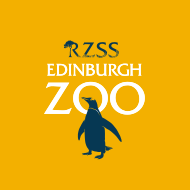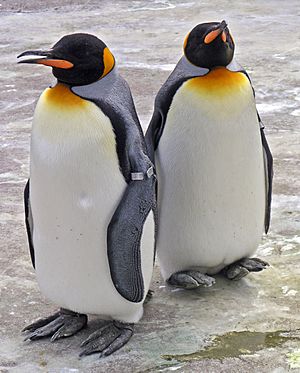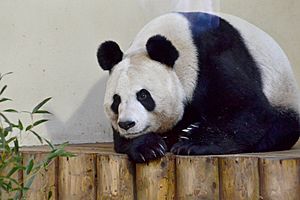Edinburgh Zoo facts for kids
 |
|
| Date opened | 22 July 1913 |
|---|---|
| Location | Edinburgh, Scotland |
| Land area | 82 acres (33 ha) |
| Coordinates | 55°56′35″N 3°16′5″W / 55.94306°N 3.26806°W |
| No. of animals | 3218 (2022) |
| No. of species | 171 |
| Annual visitors | 601,285 (2022) |
| Memberships | BIAZA, EAZA, WAZA |
| Major exhibits | Penguins, koalas, chimpanzees, sun bears, giraffes |
Edinburgh Zoo (which is called Sù Dhùn Èideann in Scottish Gaelic) is a large, 82-acre animal park in Edinburgh, Scotland. It's a special kind of park because it's a non-profit organization. This means it uses all the money it makes to care for its animals and help nature, instead of making money for owners.
The zoo is built on the side of Corstorphine Hill, which gives amazing views of the city. It first opened in 1913 and is owned by the Royal Zoological Society of Scotland. Lots of people visit Edinburgh Zoo every year, making it one of Scotland's most popular places to go. Besides being a fun place for visitors, the zoo also does important scientific work. This includes helping to breed animals that are in danger, studying how animals behave, and taking part in projects around the world to protect wildlife.
Edinburgh Zoo was the first zoo anywhere to keep and breed penguins. It is also the only zoo in Britain that has Queensland koalas. Until December 2023, it was also home to giant pandas. The zoo is part of several important groups like the British and Irish Association of Zoos and Aquariums (BIAZA). It has also received a four-star rating from the Scottish Tourism Board. The zoo's gardens are also special, with many different types of trees.
Contents
History of Edinburgh Zoo
The Royal Zoological Society of Scotland (RZSS) is a registered charity that was started in 1909 by a lawyer from Edinburgh named Thomas Hailing Gillespie. The land on Corstorphine Hill was bought by the Society in early 1913 with help from the Edinburgh Town Council.
A New Kind of Zoo Design
Thomas Gillespie wanted the zoo to be different. He was inspired by a zoo in Hamburg, Germany, called Tierpark Hagenbeck. This zoo had an "open design" with more space and natural areas for the animals. This was very different from the small, steel cages often seen in older animal collections from the Victorian era. The main design of Edinburgh Zoo was created by Patrick Geddes and his son-in-law Frank Mears.
The Scottish National Zoological Park opened to the public in 1913. In 1948, after a visit from King George VI, the Society was allowed to add the word 'Royal' to its name. This makes it the only zoo in the United Kingdom with a Royal Charter, which is a special document from the King or Queen.
The Famous Penguins
Edinburgh Zoo's connection with penguins began in January 1914. Three king penguins arrived from a whaling trip that docked in Leith. In 1919, a king penguin chick successfully hatched at the zoo. This was the first time a penguin had ever hatched in a zoo! These were also the first penguins seen outside of the South Atlantic anywhere in the world.
The zoo's famous daily penguin parade started by accident in 1950 when some birds escaped. Visitors loved it so much that it became a daily event. The parade continued until it was stopped first by the COVID pandemic and then by bird flu.
Growth and Conservation
In 1986, the RZSS also took over the Highland Wildlife Park near Kingussie. Both the zoo and the park work together to provide the best possible homes for animals in Scotland. The zoo still follows its original Royal Charter, which guides its important work in animal breeding, protecting different types of life (biodiversity), and making sure the zoo is run in a way that helps the environment.
The RZSS offers many ways for people to support its mission, like becoming a member, adopting an animal, or volunteering. Since September 2020, BBC Scotland has shown a TV series called Inside the Zoo, which is about Edinburgh Zoo and the Highland Wildlife Park.
Animals and Exhibits
Edinburgh Zoo is home to many amazing animals from all over the world.
Budongo Trail
The Budongo Trail is named after the Budongo Forest in Uganda. This area is home to a group of 13 chimpanzees. The main building has places where visitors can watch the chimpanzees. It also has a lecture theatre and fun games that teach visitors about chimpanzee life and how they live together in groups.
Living Links
Living Links is a special research center where scientists study how primates behave. This exhibit has enclosures for common squirrel monkeys and tufted capuchins.
Monkey House
The Monkey House is currently closed for new building work.
Penguins Rock
Edinburgh Zoo is very famous for its penguins. The first three king penguins arrived in January 1913. The zoo's current penguin pool, called "Penguins Rock," is very big. It is 65 meters long and 3.5 meters deep at its deepest point. It holds 1.2 million liters of water! It is home to colonies of gentoo, king, and northern rockhopper penguins.
Giant Pandas
In 2011, Edinburgh Zoo welcomed two giant pandas, a male named Yáng Guāng (meaning "sunshine") and a female named Tián Tián (meaning "sweetie"). They came from the Bifengxia Breeding Centre in China. The zoo built a special home for them. The pandas were originally planned to stay for ten years. In December 2021, it was confirmed they would stay until the end of 2023. At that time, Edinburgh Zoo was the only zoo in the United Kingdom with giant pandas.
The pandas flew back to China on December 4, 2023, ending their time in the UK.
Magic Forest
Near the sun bear habitat, the Magic Forest building houses several smaller rainforest animals. These include cotton-top tamarins, eastern pygmy marmosets, Goeldi's monkeys, and Northern Luzon giant cloud rats.
Sloths and Armadillos
This walk-through area opened in September 2021 and tells the story of South American wildlife. It is home to a pair of Linnaeus's two-toed sloths named Nico and Feira. Edinburgh Zoo is currently the only zoo in Scotland to have sloths. It also has two large hairy armadillos named Nymeria and Diogo.
Giraffe House
In 2019, Edinburgh Zoo announced plans for a new home for giraffes. They asked for public donations to help build it. Construction began in 2019, and the Giraffe House opened in June 2021. The zoo has a group of five male Nubian giraffes named Ronnie, Arrow, Gerald, Fennessy, and Gilbert.
Wee Beasties
Opened in 2017, "Wee Beasties" is an indoor exhibit that shows off some of the zoo's smaller animals. You can see blue poison dart frogs, axolotls, pancake tortoises, and different types of snails and tarantulas. There is also a coral reef tank with colorful tropical fish like percula clownfish.
Koala Territory and Wallaby Out
Koala Territory first opened in 2005. It is currently home to three female koalas: Kalari, her daughter Myaree, and her niece Talara. The area is decorated with artwork inspired by Aboriginal culture and has a garden of eucalyptus plants.
Wallaby Outback is a walk-through exhibit next to Koala Territory. It opened in 2015 and is home to swamp wallabies and western grey kangaroos.
Animal Antics
Animal Antics is a daily show where zookeepers demonstrate the natural skills of animals to visitors. The keepers use positive reinforcement training, which means the animals are never forced to participate. Because of this, the animals in the show can change each time.
Other Mammals
The zoo has many other interesting mammals. Some of these include meerkats, red pandas, pygmy hippopotamus, Asian small-clawed otters, greater one-horned rhinoceros, sun bears, Scottish wildcats, Asiatic lions, Sumatran tigers, and giant anteaters. A Sloth Bear is also a recent arrival.
Roxie the Red Panda
Roxie was a red panda who lived at Edinburgh Zoo until she passed away in November 2024. She was born on July 17, 2024, and was one of five red pandas at the zoo. Sadly, her death was believed to be caused by a reaction to fireworks set off during the city's bonfire celebrations. Veterinarians thought the noise from the fireworks caused her stress, leading her to choke. The loss of her mother five days earlier, which may also have been related to fireworks, might have made things worse.
Even though fireworks were banned in most of Edinburgh, some areas around the zoo were not included in the ban. This sad event led to new calls for stricter rules about fireworks. A public petition was signed by over one million people, and the RZSS also released a statement about the issue.
Other Birds
Other interesting bird species at the zoo include Chilean flamingos, black storks, great white pelicans, East African crowned cranes, and Egyptian vultures.
Military Animals
Some of the zoo's animals have even held military ranks!
- Wojtek was a bear adopted by Polish soldiers in Iran. He was officially enlisted into the army so he could travel with the troops. He served during World War II and later retired to Edinburgh Zoo.
- Sir Nils Olav is a king penguin who is the mascot and Colonel-in-Chief of the Norwegian King's Guard. He was adopted in 1972 and has been promoted each time the Guard visits Edinburgh. In 2008, he was even awarded a knighthood by the King of Norway!
Future Plans for Edinburgh Zoo
The giraffe house is the first of five big projects the zoo is planning as part of its "Edinburgh Zoo's Big 5" initiative. These plans include new and improved homes for the sun bears, rhinoceros, and king penguins. There will also be a new tropical house where monkeys and birds can roam freely.
Research and Conservation Efforts
Edinburgh Zoo is home to Living Links, a research center for studying how primates behave. This center was created with the University of St Andrews. It houses capuchin monkeys and squirrel monkeys from South America, giving researchers a chance to learn about their behavior.
Budongo Trail, the chimpanzee home, opened in May 2008. It is a natural-looking area that can house up to 40 chimpanzees. It has a large outdoor space and indoor areas for the chimps, along with viewing spots and a lecture theatre for visitors. The RZSS also helps fund a long-term study and conservation project for chimpanzees in the Budongo Forest in Uganda, Africa. When Budongo Trail opened, famous chimpanzee expert Jane Goodall called it a "wonderful facility."
In July 2006, a project to remove invasive brown rats from the Scottish island of Canna was successful. After two years, the island was officially declared rat-free. The rats had been harming the rare local Canna mouse and seabirds. The National Trust for Scotland worked with the RZSS to capture about 150 Canna mice and bring them to Edinburgh Zoo and the Highland Wildlife Park for safety. These mice were later returned to the island.
In May 2008, the RZSS and the Scottish Wildlife Trust (SWT) received approval to try reintroducing the European beaver to the Knapdale Forest in Scotland. If this trial is successful, the European beaver will be the first mammal to be brought back to the United Kingdom after being extinct there. Beavers disappeared from Scotland in the 16th century because they were hunted for their fur, meat, and for medicine.
Zoo Gardens
Before it became a zoo, the Corstorphine Hill site was a plant nursery. Many of the trees planted there long ago are still part of the zoo today. The zoo now has one of the most varied collections of trees in the Lothians area, with 120 different species. Because the zoo faces south, it's even warm enough to grow bananas outside! The zoo's gardening team focuses on creating natural habitats within the animal enclosures, growing food for the animals, and making the zoo a beautiful place for both animals and visitors.
See also
 In Spanish: Zoológico de Edimburgo para niños
In Spanish: Zoológico de Edimburgo para niños






